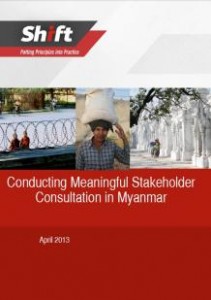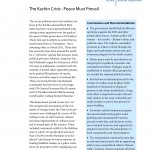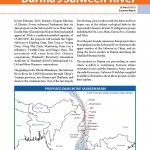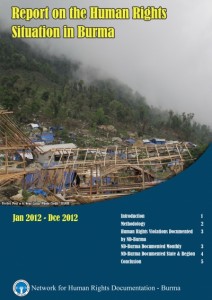Campaign Resources (403 found)
Conducting Meaningful Stakeholder Consultation in Myanmar
 Shift’s April 2013 report is designed to assist companies with the challenge of conducting meaningful consultations with stakeholders, as they consider or commence operations in Myanmar. The report (1) provides a survey of stakeholder views regarding the entry of companies into Myanmar; and (2) sets out key elements for companies to consider in their stakeholder engagement strategies […]
Shift’s April 2013 report is designed to assist companies with the challenge of conducting meaningful consultations with stakeholders, as they consider or commence operations in Myanmar. The report (1) provides a survey of stakeholder views regarding the entry of companies into Myanmar; and (2) sets out key elements for companies to consider in their stakeholder engagement strategies […]
“All You Can Do is Pray”: Crimes Against Humanity and Ethnic Cleansing of Rohingya Muslims in Burma’s Arakan State
Crimes Against Humanity and Ethnic Cleansing of Rohingya Muslims in Burma’s Arakan State
This 153-page report describes the role of the Burmese government and local authorities in the forcible displacement of more than 125,000 Rohingya and other Muslims and the ongoing humanitarian crisis […]
• • •“There is No Benefit, They Destroyed our Farmland”
This periodic update is limited in scope to provide a snapshot of overall project development. However, other impacts have been documented along the pipeline route, including environmental harms, lack of local benefits, and human rights violations, including severe human impacts in northern Shan State […]
• • •Human Rights Violations Perpetrated Against the Chin in Burma (March 2011 – March 2013)
Documentation from human rights groups shows that in fact, serious human rights violations continue across the country under President Thein Sein’s government, with particularly severe consequences for ethnic and religious minorities. For the predominantly Christian Chin people, this includes violations of religious freedom, forced labour, sexual violence, and extra-judicial killing, despite the fact that a ceasefire between armed resistance group the Chin National Front (CNF) and the government is holding […]
• • •Resolution on the Situation of Human Rights in Myanmar
The full text of the United Nations Human Rights Council Resolution that calls on the government to end human rights violations and ensure accountability and end impunity, maintains the resolution under agenda Item 4 of “Human rights situations that require the Council’s attention” and also extends the mandate of Special Rapporteur on human rights in Burma, Tomás Ojea Quintana.
• • •The Kachin Crisis: Peace Must Prevail
 The recent political unrest and military violence in the Kachin and northern Shan states has been on an unprecedented scale, raising serious questions over the goals of the quasi-civilian government of President Thein Sein and its ability to control the national armed forces (Tatmadaw). Since assuming office in March 2011, Thein Sein has received praise from around the world for a “reformist” agenda that has seen many political prisoners released, Aung San Suu Kyi’s National League for Democracy (NLD) win seats to parliament, ceasefires with the majority of armed ethnic opposition groups, and a gradual liberalisation of media, business and other aspects of national life. These are trends that the international community has been keen to encourage, with UN General-Secretary Ban Ki-moon and US President Barack Obama among world leaders visiting Burma/Myanmar […]
The recent political unrest and military violence in the Kachin and northern Shan states has been on an unprecedented scale, raising serious questions over the goals of the quasi-civilian government of President Thein Sein and its ability to control the national armed forces (Tatmadaw). Since assuming office in March 2011, Thein Sein has received praise from around the world for a “reformist” agenda that has seen many political prisoners released, Aung San Suu Kyi’s National League for Democracy (NLD) win seats to parliament, ceasefires with the majority of armed ethnic opposition groups, and a gradual liberalisation of media, business and other aspects of national life. These are trends that the international community has been keen to encourage, with UN General-Secretary Ban Ki-moon and US President Barack Obama among world leaders visiting Burma/Myanmar […]
Current Status of Dam Projects on Burma’s Salween River
 In late February 2013, Burma’s Deputy Minister of Electric Power informed Parliament that six dam projects on the Salween River in Shan State, Kayah State (Karenni) and Karen State had gained approval. With a combined installed capacity of 15,000 MW, the projects will include the Upper Salween or Kunlong Dam, Mai Tong or Tasang Dam, Nong Pha Dam, Mantawng Dam (on a tributary), Ywathit Dam, and Hatgyi Dam. The investment will come from five Chinese corporations, Thailand’s Electricity Generation Authority of Thailand (EGAT) International Co. Ltd and three Burmese corporations.
In late February 2013, Burma’s Deputy Minister of Electric Power informed Parliament that six dam projects on the Salween River in Shan State, Kayah State (Karenni) and Karen State had gained approval. With a combined installed capacity of 15,000 MW, the projects will include the Upper Salween or Kunlong Dam, Mai Tong or Tasang Dam, Nong Pha Dam, Mantawng Dam (on a tributary), Ywathit Dam, and Hatgyi Dam. The investment will come from five Chinese corporations, Thailand’s Electricity Generation Authority of Thailand (EGAT) International Co. Ltd and three Burmese corporations.
စစ္ကိုင္းတိုင္းေဒသၾကီး မံုရြာခရိုင္၊ ဆားလင္းၾကီးျမိဳ႕နယ္ လက္ပန္ေတာင္းေတာင္ ေၾကးနီစီမံကိန္း စံုစမ္းစစ္ေဆးေရး ေကာ္မရွင္၏ အျပီးသတ္အစီရင္ခံစာ
၂၀၁၂ ခုႏွစ္ ႏိုဝင္ဘာလ ၂၃ ရက္တြင္ က်င္းပေသာ ျပည္သူ႕လႊတ္ေတာ္ အစည္းအေဝး၌တင္သြင္းခဲ့သည့္ အေရးၾကီးအဆိုတြင္ စစ္ကိုင္းတိုင္းေဒ သၾကီး မံုရြာခရိုင္ ဆားလင္းၾကီးျမိဳ႕နယ္ လက္ပန္ေတာင္းေတာင္ ေၾကးနီစီမံကိန္းႏွင့္ စပ္လ်ဥ္း၍ ေၾကးနီမိုင္းလုပ္ငန္း ဆက္လက္ေဆာင္ရြက္ခြင့္ျပဳရန္ သင့္မသင့္ စံုစမ္းစစ္ေဆးေရး ေကာ္မရွင္ကို ဟ…“
• • •Losing Ground: Land Conflicts and Collective Action in Eastern Myanmar
Analysis of KHRG’s field information gathered between January 2011 and November 2012 in seven geographic research areas in eastern Myanmar indicates that natural resource extraction and development projects undertaken or facilitated by civil and military State authorities […]
• • •Report on the Human Rights Situation (January – December 2012)
 The annual report of Network for Human Rights Documentation – Burma (ND-Burma) documented the human rights situation in Burma from December 2011-January 2013. The report provides information on human rights violations (HRVs) over this period and highlights pressing issues and trends taking place in Burma. The annual report covers human rights violations in 16 categories over all 14 states. Unsurprisingly, the highest incidences of abuse occurred in ethnic nationality areas that remain in open conflict with the Burma Army, the Tatmawdaw, or are the grounds for controversial development projects […]
The annual report of Network for Human Rights Documentation – Burma (ND-Burma) documented the human rights situation in Burma from December 2011-January 2013. The report provides information on human rights violations (HRVs) over this period and highlights pressing issues and trends taking place in Burma. The annual report covers human rights violations in 16 categories over all 14 states. Unsurprisingly, the highest incidences of abuse occurred in ethnic nationality areas that remain in open conflict with the Burma Army, the Tatmawdaw, or are the grounds for controversial development projects […]

 All posts
All posts